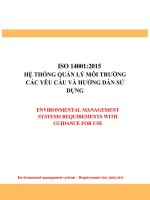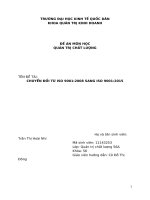ISO 9001 ISO 140001 2015 version training documents
Bạn đang xem bản rút gọn của tài liệu. Xem và tải ngay bản đầy đủ của tài liệu tại đây (839.05 KB, 40 trang )
ISO 9001:2015
Arash Niavarani
ISO 9001 - ISO 14001:2015
Copyright © 2014, CBIS P/L
ISO - Introduction
ISO = International Organisation for Standardisation
ISO standards are usually developed by its Technical Committees
(“TC’s”) and Sub-committees (“SC’s”)
ISO/TC176/SC2 (Quality Systems) is responsible for ISO 9001
ISO 9001:2015 is being developed by a specific SC2 Working
Group (“WG24”)
WG23 is responsible for Communications and Product Support
ISO 9001 - ISO 14001:2015
Copyright © 2014, CBIS P/L
ISO 9001 revisions since beginning
ISO 9001:1987
• Quality Assurance - 20 Elements
• 1st Released
ISO 9001:1994
• 20 Elements
• Minor Change
ISO 9001:2000
• Quality Management - Process Approach
• Major Change
ISO 9001:2008
• Process Approach
• Minor Change
ISO 9001:2015
• High Level Structure (Annex SL)
• Revision Planned - Major Change
ISO 9001 - ISO 14001:2015
Copyright © 2014, CBIS P/L
3
Summary of some key changes
Complete reformatting
“Goods and services” instead of “product”
Changes to “Design & Development” and “Measuring equipment” clauses
to be more appropriate for service sector
Risk management is being added with focus on risk-based thinking.
Identification of risk and risk control now is a requirement.
Elimination of the term “preventive action” (the concept still remains, and
is covered by a wider view that looks at risks and opportunities )
“External provision of goods and services” instead of “purchasing” –
includes outsourced processes
ISO 9001 - ISO 14001:2015
Copyright © 2014, CBIS P/L
Summary of some key changes
Specifying requirements considered essential to the adoption of a “process
approach”.
The terms “document” and “record” have both been replaced throughout the
Integration of strategic planning with the business
Leadership replaces Management Responsibility
Need to understand more quality tools
• FMEA
• SWOT
• Hoshin Planning
• Poke Yoke
• Customer Surveys
ISO 9001 - ISO 14001:2015
Copyright © 2014, CBIS P/L
The Revised Quality Principles
ISO 9001 - ISO 14001:2015
Copyright © 2014, CBIS P/L
High-Level Structure Comparison
ISO 9001:2008
ISO 9001:2015
0. Introduction
0. Introduction
1. Scope
1. Scope
2. Normative Reference
2. Normative Reference
3. Terms and Definitions
3. Terms and Definitions
4. Quality Management Systems
4. Context of the organisation
5.Leadership
5. Management Responsibility
6. Planning
6. Resource Management
7. Support
7. Product Realisation
8. Operation
8. Measurement, Analysis and
Improvement
9. Performance Evaluation
10. Improvement
ISO 9001 - ISO 14001:2015
Copyright © 2014, CBIS P/L
Significant Changes
ISO 9001:2008
ISO 9001:2015
0. Introduction
0. Introduction
1. Scope
1. Scope
2. Normative Reference
2. Normative Reference
3. Terms and Definitions
3. Terms and Definitions
0.3 Terms and definition
• Add some of the terms (e.g. Risk) – These may be included in ISO 9001 or in
ISO 9000
• Replace term “Product” with “Goods and Services”
• New “Risk” term is introduced
• Term “Preventive Action” is no longer a term in the new version
• Terms ”Document” and “Record” have been replaced throughout by
“Documented Information”
• Replace “Continual improvement” with “Improvement”
ISO 9001 - ISO 14001:2015
Copyright © 2014, CBIS P/L
4. Quality Management Systems
ISO 9001:2008
ISO 9001:2015
4. Quality Management Systems
4. Context of the organisation
4.1. General Requirements
4.1. Understanding the
organisation and its context
7.5. Documented information
4.2. Documentation Requirements
4.2. Understanding the needs and
expectations of interested parties
4.3. Determining the scope of
quality management system
4.4. Quality Management System
ISO 9001 - ISO 14001:2015
Copyright © 2014, CBIS P/L
Significant Changes
Determine internal and external issues that are relevant to
the objectives and strategic direction
Determine the interested parties that are relevant to the QMS
and the requirements of those parties
Determine the boundaries and applicability of the quality
management system to establish its scope as a documented
information. Exclusions limited to clause 7.1.4. Monitoring and
measuring devices and 8. Operation
More emphasis on “process approach” by introducing that as
a requirement (4.4.2. Process approach)
ISO 9001 - ISO 14001:2015
Copyright © 2014, CBIS P/L
Significant Changes
7.5 Documented information
When creating and updating documented information the organisation
shall ensure appropriate
a) identification and description (e.g. a title, date, author, or reference
number),
b) format (e.g. language, software version, graphics) and media (e.g.
paper, electronic),
Documented information shall be controlled to ensure it is adequately
protected (e.g. from loss of confidentiality)
For the control of documented information, the organisation shall
address the following activities, as applicable
a) distribution, access, retrieval and use, (access implies permission level)
ISO 9001 - ISO 14001:2015
Copyright © 2014, CBIS P/L
5. Management Responsibility
ISO 9001:2008
5. Management Responsibility
5.1. Management commitment
5.2. Customer focus
5.3. Quality policy
5.4. Planning
5.4.1. Quality objectives
5.4.2. Quality management system
planning
5.5. Responsibility, authority and
communication
5.6. Management review
ISO 9001:2015
5. Leadership
5.1. Leadership and commitment
4.2. Understanding the needs and
expectations of interested parties
5.2. Quality policy
6. Planning
6.1. Actions to address risks and
opportunities
6.2. Quality objectives and planning to
achieve them
6.3. Planning of changes
5.3. Organisational roles,
responsibilities and authorities
7.4. Communication
9.3. Management review
ISO 9001 - ISO 14001:2015
Copyright © 2014, CBIS P/L
Significant Changes
More emphasis on leadership and its role in establishment of
quality policy and objectives aligned with the strategic direction
of the organisation.
Promoting, engaging , and supporting improvement, innovation
and leadership
Top management shall be accountable for the effectiveness of
the quality management system
Term “Management Representative” has been removed,
however the tasks remain.
ISO 9001 - ISO 14001:2015
Copyright © 2014, CBIS P/L
A6DevosPresentation
Significant Changes
Determine Risks and opportunities and their potential effects on
conformity of goods and services and customer satisfaction and
have a plan to take actions to address these risks and opportunities
(e.g. SWOT, FMEA, etc.).
More emphasis on having a plan to achieve the quality objectives
and determine the needs and opportunities for change to maintain
and improve the performance of the quality management system,
identifying risks and opportunities and reviewing the potential
consequences of change.
Determine the need for internal and external communications
through a communication plan including what, when and with
whom to communicate)
ISO 9001 - ISO 14001:2015
Copyright © 2014, CBIS P/L
A6DevosPresentation
6. Resource Management
ISO 9001:2008
ISO 9001:2015
6. Resource Management
7. Support
6.1. Provision of resources
7.1. Resources
6.2. Human resources (6.2.2.
Competence , training and
awareness)
6.3. Infrastructure
7.2. Competence
7.3. Awareness
7.5. Knowledge
7.1.2 Infrastructure
6.4. Working Environment
7.1.3. Process Environment
ISO 9001 - ISO 14001:2015
Copyright © 2014, CBIS P/L
Significant Changes
7.2. Awareness
Persons doing work under the organisation‘s control shall be aware of
• the quality policy,
• relevant quality objectives,
• their contribution to the effectiveness of the quality management system, including the benefits
of improved quality performance, and
• the implications of not conforming with the quality management system requirements.
7.3. Knowledge
•
•
•
•
Competence remains, but knowledge is a new requirement
Determine the knowledge necessary for the operation of the QMS and its processes.
This knowledge shall be maintained, protected and made available as necessary.
Acquiring additional knowledge where any changes needed (refer to 6.3. planning of
changes)
ISO 9001 - ISO 14001:2015
Copyright © 2014, CBIS P/L
7. Product Realisation
ISO 9001:2008
ISO 9001:2015
7. Product Realisation
8. Operation
7.1. Planning of product realisation
8.1. Operational planning and
control
8.3. Operational planning process
8.2. Determination of market needs
and interactions with customers
8.5. Development of goods and
services
8.4. Control of external provision of
goods and services
8.6. Production of goods and
provision of services
7.1.4. Monitoring and Measuring
Devices
7.2. Customer-related processes
7.3. Design and development
7.4. Purchasing
7.5. Production and service provision
7.6. Control of monitoring and
measuring equipment
ISO 9001 - ISO 14001:2015
Copyright © 2014, CBIS P/L
Significant Changes
8.1. Operational planning and control
The organisation shall control planned changes and review the
consequences of unintended changes, taking action to mitigate any
adverse effects, as necessary.
8.3 Operational Planning Process
Implement a process to determine the following:
• b.) Actions to identify and address the risks related to achieving
conformity of goods and services to requirements. ( such as FMEA)
ISO 9001 - ISO 14001:2015
Copyright © 2014, CBIS P/L
A6DevosPresentation
Significant Changes
8.4 Control of External Provision of Goods and Services
• Term “Purchasing” is replaced by “Outsourcing” and “external
provision”
• The type and extent of control shall be dependent upon the risks
identified and the potential impacts,
• Documented information shall be provided to the external
provider describing, where appropriate:
• e) the control and monitoring of the external provider’s performance to be
applied by the organisation,
• g) the requirements for handling of external provider’s property provided
to the organisation.
ISO 9001 - ISO 14001:2015
Copyright © 2014, CBIS P/L
A6DevosPresentation
Significant Changes
8.5 Development of Goods and Services
• 8.5.1 Development Processes
Consistent with the Process Approach and considering risks and
opportunities (DFMEA, etc.]
• 8.5.2 Development Controls
Merging and de-emphasising design and development
verification, validation and change control and make them more
generic
• 8.5.3 Development Transfer
The organisation shall ensure that transfer from development to
production or service provision only takes place when actions
outstanding or arising from development have been completed
ISO 9001 - ISO 14001:2015
Copyright © 2014, CBIS P/L
A6DevosPresentation
Significant Changes
8.6 Production of Goods, Provision of Services
8.6.1 Control of production of goods and provision of services
i.) prevention of nonconformity due to human error, such as unintentional
mistakes and intentional rule violations (Poke Yoke)
8.6.2 Identification and Traceability
8.6.3 Property belonging to customers or external providers
8.6.4 Preservation of Goods and Services
ISO 9001 - ISO 14001:2015
Copyright © 2014, CBIS P/L
A6DevosPresentation
Significant Changes
8.6.5 Post Delivery Activities
Determine and meet requirements for post delivery activities (warranty
provisions, maintenance services, etc.). Taking into account of
a) the risks associated with the goods and services,
b) customer feedback, and
c) statutory and regulatory requirements.
8.6.6 Control of Changes
The organisation shall undertake change in a planned and systematic
manner, considering the review of the potential consequences of
changes (see 6.3. planning of changes) and taking action as necessary,
to ensure the integrity of goods and services are maintained.
ISO 9001 - ISO 14001:2015
Copyright © 2014, CBIS P/L
Significant Changes
7.1.4. Monitoring and Measuring Devices
• In its attempt to make “calibration” requirements less manufacturingcentric, many of the requirements of ISO 9001:2008 have been
removed.
• Customer surveys, etc. can now be considered as a monitoring device
ISO 9001 - ISO 14001:2015
Copyright © 2014, CBIS P/L
8. Measurement, analysis and improvement
ISO 9001:2008
8. Measurement, analysis and
improvement
8.1. General
ISO 9001:2015
9. Performance Evaluation
9.1. Monitoring, measurement, analysis
and evaluation (9.1.1. General)
8.2. Monitoring and measurement
8.2.1. Customer Satisfaction
8.2.2. Internal Audit
8.2.3. Monitoring and
measurement of processes
8.2.3. Monitoring and
measurement of product
8.3. Control of nonconforming
product
8.4. Analysis of data
8.5. Improvement
9.1.2. Customer satisfaction
9.2. Internal Audit
9.1.1. Genera
8.7. Release of goods and services
8.8. Nonconforming goods and services
9.1.3. Analysis and evaluation of data
10.1. Nonconformity and corrective action
10.2. Improvement
ISO 9001 - ISO 14001:2015
Copyright © 2014, CBIS P/L
Significant Changes
9.1. Monitoring, measurement, analysis and evaluation
The organisation shall take into consideration the determined risks
and opportunities
9.2. Internal Audit
The audit programme(s) shall take into consideration the quality
objectives, the importance of the processes concerned, the related
risks, and the results of previous audits;
ISO 9001 - ISO 14001:2015
Copyright © 2014, CBIS P/L
A6DevosPresentation









